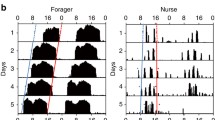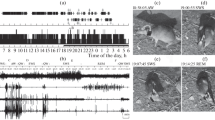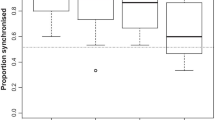Summary
Deer mice (Peromyscus maniculatus), kept in individual cages under constant dim-light conditions, displayed steady free-running rhythms of activity, the period of which varied between individuals.
When two previously isolated mice with different rhythms were placed in a common enclosure, under the same constant light conditions, they soon displayed a mutual synchronization of their activity rhythms. When separated again, the mice lost mutual synchronization (Figs. 1 and 2)
The process by which mutual synchronization was attained in the common enclosure is typical of entrainment by an external synchronizer (Zeitgeber). Our results suggest that the activity rhythm of the dominant mouse entrains the activity rhythm of the subordinate, and is thus a ‘social Zeitgeber.’
Similar content being viewed by others
References
Aschoff J, Wever R (1963) Resynchronisation der Tagesperiodik von Vögeln nach Phasensprung des Zeitgebers. Z. Vergl Physiol 46:321–335
Bovet J (1972) On the social behavior in a stable group of longtailed field mice (Apodemus sylvaticus). II. Its relation with distribution of daily activity. Behaviour 41:55–67
Bovet J, Oertli EF (1974) Free-running circadian activity rhythms in free-living beaver (Castor canadensis). J Comp Physiol 92:1–10
Bünning E (1973) The physiological clock, 3rd edn. Springer, Berlin Heidelberg New York
DeCoursey P (1961) Effect of light on the circadian activity rhythms of the flying squirrel, Glaucomys volans. Z Vergl Physiol 44:331–354
Eisenberg JF (1962) Studies on the behavior of Peromyscus maniculatus gambelii and Peromyscus californicus parasiticus. Behaviour 19:177–207
Enright JT (1965) The search for rhythmicity in biological timeseries. J Theor Biol 8:426–468
Falls JB (1968) Activity. In: King JA (ed) Biology of Peromyscus (Rodentia). Spec Publ Am Soc Mamm 2:543–570
Farr L, Andrews RV (1978) Rank-associated desynchronization of metabolic and activity rhythms of Peromyscus maniculatus in reponse to social pressure. Comp Biochem Physiol [A] 61:539–542
Farr LA, Andrews RV, Kline MR (1978) Comparison of methods for estimating social rank of deer mice. Behav Biol 23:399–404
Gwinner E (1966) Periodicity of a circadian rhythm in birds by species-specific song cycles (Aves, Fringillidae: Carduelis spinus, Serinus serinus). Experientia 22:765–766
Hill JL (1977) Space utilization of Peromyscus: social and spatial factors. Anim Behav 25:373–389
Hoffmann K (1969) Die relative Wirksamkeit von Zeitgebern. Oecologia (Berlin) 3:184–206
Kavanau JL (1963) The study of social interactions between small mammals. Anim Behav 11:263–273
Loher W (1979) The effect of male calling on female locomotor activity of Teleogryllus commodus. Behav Ecol Sociobiol 5:383–390
Menaker M, Eskin A (1966) Entrainment of circadian rhythms by sound in Passer domesticus. Science 154:1579–1581
Nygren J (1978) Interindividual influence on diurnal rhythms of activity in cycling and noncycling populations of the field vole, Microtus agrestis L. Oecologia (Berlin) 35:231–239
Palmer JD (1976) An introduction to biological rhythms. Academic Press, New York
Pöppel E (1968) Desynchronisation circadianer Rhythmen innerhalb einer isolierten Gruppe. Pfluegers Arch 299:364–370
Potvin C, Bovet J (1975) Annual cycle of patterns of activity rhythms in beaver colonies (Castor canadensis). J Comp Physiol 198:243–256
Rawson KS (1959) Experimental modification of mammalian endogenous activity rhythms. In: Withrow RB (ed) Photoperiodism and related phenomena in plants and animals. AAAS, Washington, pp 791–800
Roper TJ, Ryon J (1977) Mutual synchronization of diurnal activity rhythms in groups of red wolf/coyote hybrids. J Zool 182:177–185
Sadleir RMFS (1970) The establishment of a dominance rank order in Peromyscus maniculatus and its stability with time. Anim Behav 18:55–59
Saunders DS (1977) An introduction to biological rhythms. John Wiley and Sons, New York
Stinson RH (1960) The timing of the activity pattern of Peromyscus in constant darkness. Can J Zool 38:51–55
Author information
Authors and Affiliations
Rights and permissions
About this article
Cite this article
Crowley, M., Bovet, J. Social synchronization of circadian rhythms in deer mice (Peromyscus maniculatus). Behav Ecol Sociobiol 7, 99–105 (1980). https://doi.org/10.1007/BF00299514
Received:
Accepted:
Issue Date:
DOI: https://doi.org/10.1007/BF00299514




